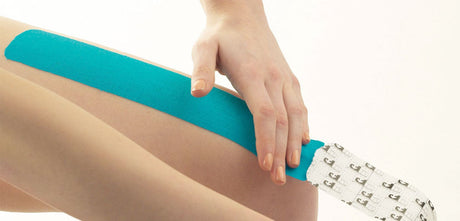Applying Kinesiology tape for shin pain is quick and easy. It helps reduce discomfort associated with conditions like medial tibial stress syndrome (shin splints) or stress fractures.
Materials needed
- Kinesiology tape
- Scissors
- Skin-friendly adhesive spray (optional)
- A clean and dry surface (your skin)
Prepare the area
When applying Kinesiology tape for shin pain, prepare the tape and your skin first. Make sure the skin is clean and dry over the area you intend to apply the Kinesiology tape.
If your skin is hairy then it is probably best to shave the area so the tape sticks better. Do not use underwrap. The Kinesiology tape needs to be in contact with the skin. If you have sensitive skin or are prone to allergies then opt for a tape that is hypoallergenic.

Measure and cut the Kinesiology tape
Measure the length of kinesiology tape you’ll need. Typically, you’ll want a strip long enough to cover the affected area of your shin. Cut the tape to the desired length, but round the edges to prevent the corners from peeling prematurely. Tear the backing paper from one end of the kinesiology tape, leaving a few inches of unpeeled tape.
Apply the anchor point
Place the unpeeled end on the skin, slightly above the painful area on your shin. This serves as an anchor point.

Tension/stretch the tape
For shin pain gently stretch the kinesiology tape as you apply it over the painful area. The amount of stretch depends on the level of support and compression you need. Be cautious not to overstretch, as it may become uncomfortable. Apply the stretched tape directly over the painful area, following the line of your shin. Make sure the tape adheres smoothly without wrinkles.
Secure the end
Once you’ve covered the painful area, release the tension on the tape and let it relax. Peel off the remaining backing paper and apply the end of the tape without stretching it. Ensure that it sticks well.
Activate the glue
Gently rub the entire length of the tape with your hand to activate the adhesive and ensure good adhesion to your skin. Give the tape a few minutes to adhere fully to your skin before engaging in any strenuous activity or applying pressure to the taped area. Allow the tape to set.

Apply a cross strip
If there is any excess tape extending beyond the painful area, carefully trim it with scissors. If needed, you can apply additional strips of Kinesiology tape across the original strip. Apply tension so as to pull the muscle towards the bone.
Be aware of contraindications of Kinesiology tape for shin pain
Remember that kinesiology tape is typically well-tolerated, but if you experience any skin irritation, discomfort, or worsening pain, remove the tape immediately. It’s essential to consult with a healthcare professional if you have severe or persistent shin pain to determine the underlying cause and appropriate treatment.
External links
- Learn more about shin pain & shin splints at Sportsinjuryclinic.net










